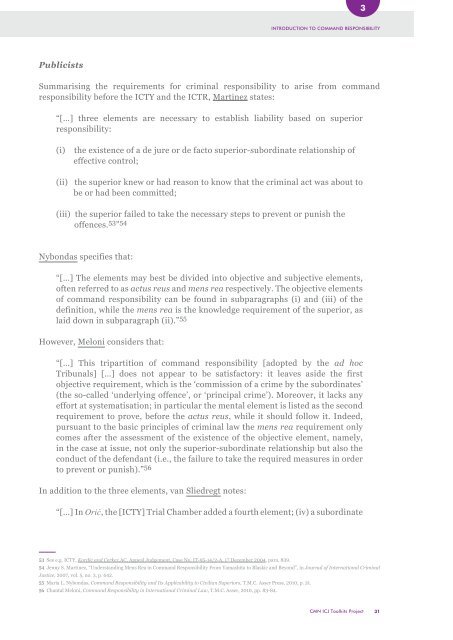Command Responsibility
CMN_ICL_Guidelines_Command_Responsibility_En
CMN_ICL_Guidelines_Command_Responsibility_En
You also want an ePaper? Increase the reach of your titles
YUMPU automatically turns print PDFs into web optimized ePapers that Google loves.
3<br />
INTRODUCTION TO COMMAND RESPONSIBILITY<br />
Publicists<br />
Summarising the requirements for criminal responsibility to arise from command<br />
responsibility before the ICTY and the ICTR, Martinez states:<br />
“[…] three elements are necessary to establish liability based on superior<br />
responsibility:<br />
(i)<br />
the existence of a de jure or de facto superior-subordinate relationship of<br />
effective control;<br />
(ii) the superior knew or had reason to know that the criminal act was about to<br />
be or had been committed;<br />
(iii) the superior failed to take the necessary steps to prevent or punish the<br />
offences. 53 ” 54<br />
Nybondas specifies that:<br />
“[…] The elements may best be divided into objective and subjective elements,<br />
often referred to as actus reus and mens rea respectively. The objective elements<br />
of command responsibility can be found in subparagraphs (i) and (iii) of the<br />
definition, while the mens rea is the knowledge requirement of the superior, as<br />
laid down in subparagraph (ii).” 55<br />
However, Meloni considers that:<br />
“[…] This tripartition of command responsibility [adopted by the ad hoc<br />
Tribunals] […] does not appear to be satisfactory: it leaves aside the first<br />
objective requirement, which is the ‘commission of a crime by the subordinates’<br />
(the so-called ‘underlying offence’, or ‘principal crime’). Moreover, it lacks any<br />
effort at systematisation; in particular the mental element is listed as the second<br />
requirement to prove, before the actus reus, while it should follow it. Indeed,<br />
pursuant to the basic principles of criminal law the mens rea requirement only<br />
comes after the assessment of the existence of the objective element, namely,<br />
in the case at issue, not only the superior-subordinate relationship but also the<br />
conduct of the defendant (i.e., the failure to take the required measures in order<br />
to prevent or punish).” 56<br />
In addition to the three elements, van Sliedregt notes:<br />
“[…] In Orić, the [ICTY] Trial Chamber added a fourth element; (iv) a subordinate<br />
53 See e.g. ICTY, Kordic and Cerkez,AC, Appeal Judgement, Case No. IT-95-14/2-A, 17 December 2004, para. 839.<br />
54 Jenny S. Martinez, “Understanding Mens Rea in <strong>Command</strong> <strong>Responsibility</strong> From Yamashita to Blaskic and Beyond”, in Journal of International Criminal<br />
Justice, 2007, vol. 5, no. 3, p. 642.<br />
55 Maria L. Nybondas, <strong>Command</strong> <strong>Responsibility</strong> and Its Applicability to Civilian Superiors, T.M.C. Asser Press, 2010, p. 31.<br />
56 Chantal Meloni, <strong>Command</strong> <strong>Responsibility</strong> in International Criminal Law, T.M.C. Asser, 2010, pp. 83-84.<br />
CMN ICJ Toolkits Project<br />
31


